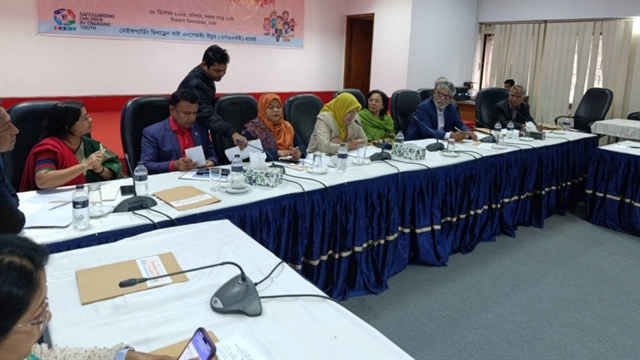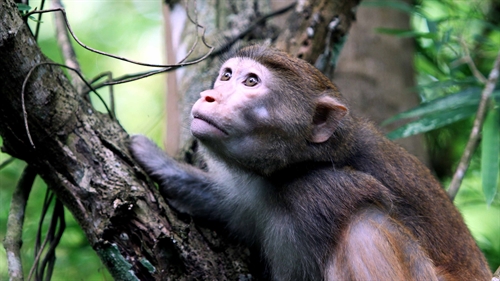 Environment
Environment

Việt Nam’s rich biodiversity has been under threat due to overloaded exploitation, illegal wildlife hunting and trafficking, as well as poor management and collaboration among State agencies.
 |
| A stump-tailed macaque lives in the 94,804ha Pù Mát National Park in the central province of Nghệ An. Việt Nam’s rich biodiversity has been under threat due to overloaded exploitation, illegal wildlife hunting and trafficking, as well as poor management and collaboration among State agencies. — VNA/VNS Photo An Đăng |
ĐÀ NẴNG — Việt Nam’s rich biodiversity has been under threat due to overloaded exploitation, illegal wildlife hunting and trafficking, as well as poor management and collaboration among State agencies.
Deputy General Director of the Việt Nam Administration of the Forestry (VNFOREST) Cao Chí Công spoke at a seminar titled Enhancing Collaboration For Nature Conservation in the Central and Central Highlands regions of Việt Nam in Đà Nẵng on Wednesday.
Forests cover 62 per cent of the region on 3.4 million hectares – the largest area in Việt Nam. They play an important role for the lower Mekong River.
Công said many policies were built in the past years, but it’s still a challenge to manage and protect biodiversity and endangered flora and fauna at national nature reserves and parks.
“Illegal trafficking of wildlife or hunting of endangered animals in forests has concerned State agencies and biologists recently," Công said. "The Government also built up strong policies on how to promote environment and forest protection, but action is needed to curb illegal logging, hunting and trafficking of wild animals in forests and parks."
He said the Government plans to build 176 nature reserves and parks with total area of 2.4 million hectares by 2020 to protect biodiversity.
Công also said Việt Nam had eyes on establishing more than 60 wetlands and marine protected areas in 2020, as well as more ASEAN heritage gardens, UNESCO-recorgnised biospheres and world heritage nature areas.
He said Việt Nam received positive support from NGOs and foreign countries in developing personnel training and endangered wildlife rescue centres.
Nguyễn Mạnh Hiệp of the Nature Conservation Department under VNFOREST said alarming illegal poaching and wildlife trade for food and medicine has driven some endangered animals, such as the rhino; saola; and Vũ Quang ox (Asian bicorn), one of the world’s rarest large mammals, into extinction in Việt Nam.
He said illegal logging, poor management at nature reserves, a lack of funds for forest protection and a lack of strict punishment on illegal hunting and logging for damage to the natural world.
Hi ệp, however, could not report on figures and records of illegal logging, wildlife hunting and trade in Việt Nam.
He also said communities around nature reserves and national parks lived in poor conditions, and had yet to benefit from forest products.
Professor Đặng Huy Hiệp, chairman of the Việt Nam Animal Association, said Việt Nam had only 11,000 rangers working at national reserves and parks, and it needed co-operation and involvement of local communities in order to protect the forest.
He said overlapped management among ministries, departments and local administrations also led to poor conservation strategies.
According to the Việt Nam Association of National Parks and Nature Reserves, the country currently has 164 nature reserves, with over 2 million hectares of special-use forests. But only 10 per cent of rangers have been educated on biodiversity. Just three or four of the 30 rangers working at the reserve had been trained in biodiversity management.
Hà Thăng Long, head of the representative office of the Frankfurt Zoological Society, said it had followed a long-term strategy on biodiversity and langur conservation in national parks and nature reserves in Ninh Bình, Quảng Bình, Khánh Hoà , Gia Lai, Đắk Lắk and Kon Tum since 1991, with an annual budget of between US$200,000 and 250,0000 that helped pay for rangers to patrol the forests regularly.
"The joint action by NGOs and Government agencies will pave the way for a long-term strategy on wildlife and biodiversity protection in parks and natural reserves in Việt Nam," Long said.
Long said the Frankfurt Zoological Society’s Việt Nam Primate Conservation Programme recorded a community of 350 grey-shanked douc langurs (pygathrix cinerea), a critically endangered species in Kon Ka Kinh Park in Gia Lai Province.
The Frankfurt Zoological Society’s Việt Nam Primate Conservation Programme rescued 260 primates. It also facilitated reproduction in 12 primates species, including the grey-shanked douc langur, Hà Tĩnh langur and Delacour’s langur, at the Cúc Phương Endangered Primate Rescue Centre.
Việt Nam has more than 13,000 species of flora, about 10,000 species of fauna and more than 3,000 aquatic plant species, according to VNFOREST.
Forest biodiversity faces great pressure from the 25 million people living near forests, 20 per cent of whom depend on the forests to make a living. — VNS




